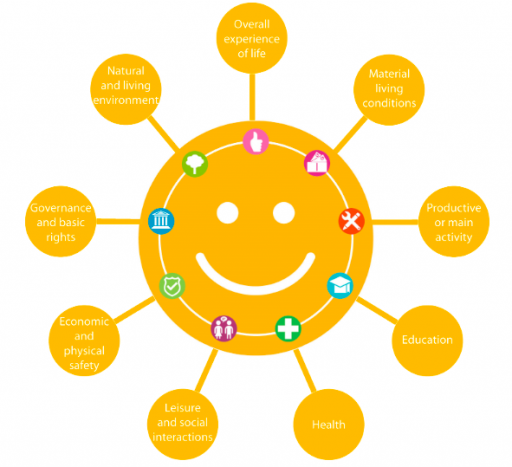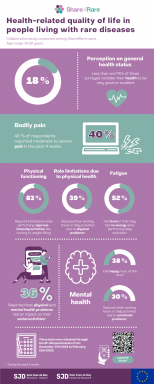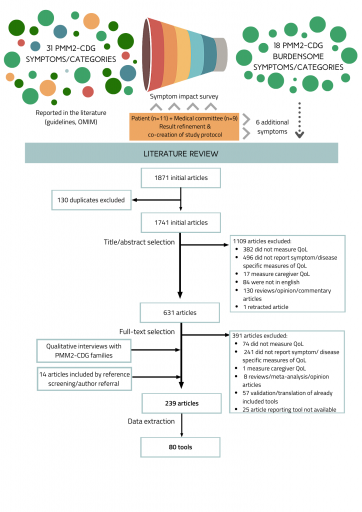Quality of Life
In this section:
-
Quality of Life (QoL)
-
What is health-related quality of life (HrQoL) and why is it important?
-
Current research Dedicated to CDG
-
Future perspectives for QoL in CDG
How can you help our CDG community? Is easy! Share among your social media and other channels the information we make available within this section and website. This raises awareness, accelerates diagnosis, and secures better care and management for our CDG children and adults!
What is Quality of Life?
The World Health Organization (WHO) defines Quality of Life (QoL) as an individual's perception of their position in life in the context of the culture and value systems in which they live and in relation to their goals, expectations, standards and concerns.
QoL is a concept that depends on multiple aspects of people’s lives:

Source: https://ec.europa.eu/eurostat/web/quality-of-life/data
What is health-related quality of life (HrQoL) and why is it important?
Health related quality of life (HrQoL) is the health aspect of QoL that focuses on people’s level of ability, daily functioning and ability to experience a fulfilling life. It can be also described as the evaluation of the impact of the health status in domains related to physical, mental, emotional, and social functioning.
There are many factors that can impact a person’s HRQoL, which include:
- Disease
- Injury
- Impairment
- Health perceptions
- Health care and treatments
- Policy
HrQoL research is pivotal for any population and/or disease. It helps people understand how health, disease and treatment impact the QoL.
People are then better able to, for example :
- Understand the potential benefits and risks of a proposed treatment
- Weigh the impact of a decision on symptoms, function and life expectancy
- Live their lives more fully
An understanding of QOL and HrQoL also enables health program developers and policy makers to better allocate resources.
To measure and study HrQoL, researchers and clinicians resort to patient-reported outcome measures (PROMs) or observer-reported outcome measures (ObsROMs).
What are PROs, PROMs and ObsROMs?
PROs - Patient reported outcomes - are any report of the status of a patient’s health condition or health behaviour that comes directly from the patient, without interpretation of the patient’s response by a clinician or anyone else. Self-reported patient data provide a rich data source for outcomes. This definition reflects the key domains:
- Health-related quality of life (including functional status)
- Symptoms and symptom burden (e.g., pain, fatigue)
- Health behaviours (e.g., smoking, diet, exercise)
To better understand what PROs are, watch this video from the Canadian Partnership Against Cancer:
PROMs - Patient reported outcome measures - PROMs are tools used to collect patient-reported outcomes directly collected from patients/people living with a disease.
To better understand what PROMs are, watch this educational webinar from Dr. Adam Smith:
ObsROMs - Observer-reported outcome measures - tools that allow to obtain reports made by a proxy (a person who is in direct contact with the patient) when it is not possible to obtain self-reports (e.g. in case of intellectual disability).
What makes high quality PROMs/ObsROMs?
- They cover the a desired and meaningful outcome from the patient and/or caregiver perspective
- They are reliable (i.e. trustworthy and consistent)
- They are valid (i.e. they measure what they are supposed to measure)
- They are easy to use (i.e. accessible, for instance in paper or digital format)
- They are easy to complete (i.e., short, little time and effort to complete)
- They fit with standard of care (i.e., they are appropriate and updated according to the current medical care and interventions)
- They are readable (i.e., easy to understand)
- They are appropriate to the country culture (i.e., the social and health culture changes from country to country; therefore, PROMs and ObsROMs need to be adapted according to the specificities of where they are administered)
- They are well translated (i.e. some terms might differs from country to country, so there is the need to make sure the translation uses culturally appropriate items)
- They have established clinical terms and codes (i.e., they are concordant to the standard medical terminology)
- They have clear instructions (i.e., they tell exactly what needs to be done so that data collection is optimised)
- They should be developed by consulting clinical experts, including patients, their caregivers and patient advocates, to help them define appropriate and meaningful outcomes.
PROMs and ObsROMs can be general or disease/symptom specific. Below, you can find what are the advantages and disadvantages of each.

HrQoL and PROMs/ObsROMs and in rare diseases and in CDG
While some rare diseases do not necessarily affect life expectancy, the majority lead to physical, emotional and/or psychosocial limitations with a wide range of disabilities. This can be due to their chronic nature, complexity, severity and even the lack of treatments.
A survey from Share4Rare aimed to identify the impact of having a rare disease in the patient’s QoL and identified several aspects of their lives affected:

For more information and results about this study, click HERE.
Besides its importance, the study of QoL in rare diseases is challenging due to methodological issues as well as to limited literature on those conditions. Some challenges to this research topic are:
- Small patient populations
- Disease heterogeneity
- Scarcity of medical knowledge
- Not fully understanding of the burden of these diseases.
Like other rare diseases, CDG faces this and more challenges. Particularly, besides the fact that many CDGs have less than a dozen people diagnosed worldwide, the clinical presentation between different CDGs and even between patients with the same CDG greatly varies.
Currently, there are no disease-specific QoL PROMs/ObsROMs for PMM2-CDG which is a gap in the drug approval process. Besides, there are very few QoL research reports in CDG. The most significant contribution in this topic concerns PMM2-CDG, which is the most prevalent CDG. Specifically, Ligezka et al 2020 reported that, in PMM2-CDG patients, the physical activity, strength impact, upper extremity, physical mobility, and satisfaction in social roles (peer relationships) are most affected domains compared to US general population. Furthermore, there seems to be a strong correlation between current functional ability and some PROMIS subscales. To get access to the full article, click HERE.
Despite the lack of information, small but important steps are being taken in the right direction. In an era where potential therapies are appearing on the horizon, it is important to bring adequate PROs to the community that will include meaningful clinical endpoints in future clinical trials.
Current research Dedicated to CDG
Given the current state and importance of QoL knowledge in the CDG field, the CDG & Allies international research network has been making significant contributions.
Back in 2018, the CDG & Allies team reviewed the literature and gathered the PROMs and ObsROMs that are used in other inherited metabolic disorders, like CDG. Despite the CDG particularity, some aspects of these diseases are similar to the ones of CDG and therefore, some key learnings were identified for future research.
To access the full article, please click HERE.
However, CDG complexity and heterogeneity makes them a unique set of diseases. The severity and burden between patients and their families can be rather disparate. Consequently, there is no one-size fits all solution that will cover the needs for all the families affected by these conditions. Particularly in this scenario, it is particularly important to hear the voice of the community, and be as inclusive as possible and value the needs of each individual.
That is why CDG & Allies are working towards a creative and tailored solution for the CDG community, promoting the engagement of all expert stakeholders, including CDG families, medical professionals, and pharma representatives.
Focusing firstly on PMM2-CDG, an expert committee was created to identify what aspects of the disease constitute a major burden for the patient’s quality of life. Importantly the vision of the medical doctors and patient caregivers complemented each other. On the one hand, caregivers highlighted aspects related to the real-world daily living which might not be visible during medical appointments. On the other hand, medical doctors can contribute with their extensive knowledge and experience derived from dealing with many different patients during many years.
A sum up of the main CDG impactful signs and symptoms across the patient lifetime can be found below:

Understanding what are the most impactful signs and symptoms allowed us to look for tools that could evaluate the QoL specifically to those clinical manifestations. An overview of this study can be found below and a scientific article will soon be published and made available.

This inclusive community-centric approach provides meaningfulness to the process, but also can maximise data collection, ultimately allowing the creation of QoL tools that are sensitive and tailored to the disease, which is vital to delivering and appraising potential therapeutics.
Future perspectives for QoL in CDG
This work developed by CDG & Allies provides steps towards the development of a PMM2-CDG QoL questionnaire while assuring the engagement and participation of families and doctors in its creation. This community-inclusive methodology complements clinically important factors (doctors views) with aspects that make life worth living (patients and families’ views) and should be adopted for the next steps of the tool development.
Further work on this topic will require and benefit from combined efforts from all stakeholders, particularly families, researchers, clinicians, and pharma representatives. Only by working together will we be able to tackle the particularities of CDG and make sure that a PMM2-CDG QoL questionnaire is tailored and responsive to the needs of the community.
This tool will be beneficial not only for therapy assessment and approval but also for establishing the natural history of the disease in terms of QoL. In turn, it will provide insights on best practices for applying the same methodology to other CDGs.
For a simple explanation of the overall project, what the next video from CDG & Allies:
Interesting literature:
- Carlota Pascoal, Sandra Brasil, Rita Francisco, Dorinda Marques-da-Silva, Agnes Rafalko, Jaak Jaeken, Paula A. Videira, Luísa Barros and Vanessa dos Reis Ferreira, Patient and observer reported outcome measures to evaluate health-related quality of life in inherited metabolic diseases: a scoping review. Orphanet Journal of Rare Diseases (2018) 13:215 https://doi.org/10.1186/s13023-018-0953-9. Access HERE.
- Anna N Ligezka, Anab Mohamed, Carlota Pascoal, Vanessa Dos Reis Ferreira, Suzanne Boyer, Christina Lam, Andrew Edmondson, Wirginia Krzysciak, Raphael Golebiowski, Judit Perez-Ortiz, Eva Morava, Patient-reported outcomes and quality of life in PMM2-CDG, Mol Genet Metab. 2022 Jun;136(2):145-151. doi: 10.1016/j.ymgme.2022.04.002. Access HERE.
Keep in mind, you are not alone. Though Congenital Disorders of Glycosylation (CDG) are categorized as “rare” there is an amazing community at your fingertips working day and night to improve the lives of many people living with CDG and their family members. We want you to know everything that is available about therapies in lay language, but we suggest you enter into it at your own pace and comfort level.
Secure that you are up to date about Quality of Life advances in CDG, and join our mailing list:
For further learning about CDG, move ahead to our community tailored sections across https://worldcdg.org/
Didn't find what you are looking for?
Your question may help others
Authors
Carlota Pascoal and Ana Sofia Rodrigues (CDG & Allies, FCT - NOVA University, World CDG Organization and Portuguese Association for CDG).
Revisors
Pedro Granjo (CDG & Allies, FCT - NOVA University, World CDG Organization and Portuguese Association for CDG).
Content managers and peer reviewers
Marisa Godinho and Ana Verde (collaborators at CDG & Allies FCT, NOVA University).
Disclaimer
The Site cannot and does not contain medical or health advice. The information is provided for general informational and educational purposes only and is not a substitute for professional advice.
Accordingly, before taking any actions based upon such information, we encourage you to consult with the appropriate professionals. We do not provide any kind of medical or health advice. The use or reliance of any information contained on this site is solely at your own risk.
Follow Us
Like the World CDG Organization Facebook Page. Share the page on your own timeline and tell your friends to share it.
Follow us on Twitter and LinkedIn.
Subscribe to our Youtube channel and invite your friends to subscribe too.

